Martial Arts: Karate
Interview With Roy Suenaka On Hohan Soken & Tuidi
By Christopher Caile
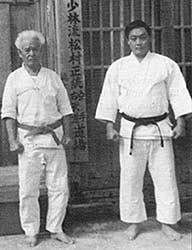 |
Grand Master Hohan Soken with his student Roy Suenaka outside his home on Okinawa in 1970 |
Introduction
Roy Suenaka Sensei is best known as the founder of Wadokai Aikido, which reflects his own training directly under aikido's founder, Morihei Ueshiba, as well as Koichi Tohei. Less known is Suenaka's long term in-house study with Hohan Soken, the great Okinawan karate master known for his White Crane karate. White Crane was taught to senior students inside a Shorin Ryu karate curriculum. Soken traced his techniques to Bushi Matsumura (1762-1843), the great Shuri karate master, body guard to the Okinawan king and diplomat. Matsumura served as a well spring from which a whole generation of Okinawan karate pioneers emerged.
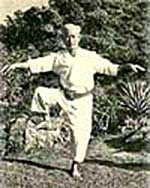 |
Hohan Soken demonstrating a stance from White Crane. |
|
Today Suenaka Sensei, 8th dan, continues Soken's karate legacy in Charleston, S.C., teaching his Matsumura Seito Hakutsuru (Orthodox Matsumura White Crane) Shorin-ryu Karate-do and Kobudo (weapons). The style is crisp yet graceful, incorporating some grappling and many traditional karate weapons. White Crane techniques are soft and flowing contrasted to the harder, more direct power of traditional Shorin-Ryu. In addition to karate, Soken is known for his tuidi, (1) also sometimes referred to as tuite, toude, torite or karamiti. |
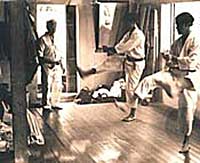 |
An old photo showing Hohan Soken leading students in a small class conducted on the porch of his home on Okinawa. |
Toudi is rarely seen today. If practiced at all, it is considered a complement to karate, not part of it. Tuidi means grabbing/gripping hand and includes an eclectic panorama of self-defense techniques. Included are parrying, entangling, entrapment, grabbing, body and arm control techniques, plus pressure point striking and nerved control techniques.
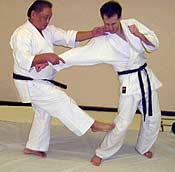 |
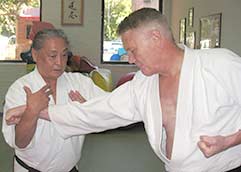 |
Roy Suenaka who teaches Soken's Matsumura Seito Hakutsuru Shorin-ryu Katatedo and Kobudo along with his own Wadokai Aikido in Charleston, S.C. executes a simultaneous open hand counter and foot tuidi technique on his senior student Chad Taylor. |
Roy Suenka shows a tuidi trap of a punch thrown by Christopher Caile. Notice Suenaka's open hands on either side of the punching arm, the left just below the outside of the elbow (deflecting the punch) the other inside the wrist tapping the arm -- the two together allowing capture of the arm and control of the elbow (also unbalancing forward). Typically with this technique the elbow can be broken or bent inward unbalancing the attacker and creating an opening for a variety of counter attacks. |
The art's origin is obscure. Some historians suggest toudi was once part of old time karate (often referred to as "ti" or "te", meaning hand), but was lost in karate's transition to modern form. Others suggest "ti" (hand) refers to old Okinawan karate, while tuidi refers to techniques derived from Chinese roots (often called tode, meaning Chinese Hand, the term sharing the same characters, but pronounced differently from the original characters used for karate). Still others suggest that tuidi represents a separate and older Okinawan indigenous art. No one knows for sure. In some ways the art of tuidi is similar to Chinese chin na, comprising jujutsu or aikido-like techniques, plus grabbing and striking components. Many of these techniques Suenaka routinely teaches as part of his karate. The are also included in many aikido classes, seminars and camps.
Interview
Q: How did Hohan Soken refer to the old Okinawan art that complemented his karate? Did he call it tuidi, tuite, toude, torite or something else?
Suenaka: Soken Sensei pronounced it as tuidi (tu-ee-d). I know others refer to it by other names but Soken may have called it toudi because of the area that he lived in. That part of Nishihara is considered the backwoods country of Okinawa and thus the term may have been an older pronunciation.
Q: How are tuidi foot movements you learned from Hohan Soken different from those in aikido?
Suenaka: Basically the footwork is very similar in that you step at angles or you pivot out the way of an attack. The tuide portion is also similar to aikido in that you don't grab or don't actually block, but blend with the attack to capture it.
Q: In aikido you most often end with a throw?
Suenaka: With a wrist or other body part.
Q: In some tuidi techniques you seem to be actually off balancing the opponent with elbow positions, or by something else, such as by pulling them in, and then finishing up with a .... (Suenaka finished the sentence).
Suenaka: ... with a strike or a disabling never strike, yes.
Q: When you practiced with Soken, what was the typical practice? How much would you be practicing tuide versus kata?
Suenaka: Well, we would be doing kata and then apart from kata we would go through their separate movements, like bunkai (break down of kata technique). I would often practice this by myself. When we would practice tuidi, we of course would have to work with a partner. Basically, if it was one on one, it would be myself and Soken Sensei and he would be showing me tuidi. Most of the emphasis was on tuidi rather than on kata bunkai. Of course, we did some kata bunkai too. The kata we practiced alone. Soken would teach a kata and then let you practice it yourself, over and over. Often he would leave you alone, only to check you later.
Q: So Soken preferred tuidi?
Suenaka: Oh yes. In the average session in Soken's house if I was not doing kata (he often practiced alone), we would be doing tuidi.
Q: Did Soken tell you how he learned tuidi?
Suenaka: Well, actually he knew Go Genki (an Okinawan White Crane exponent also known to have influenced Chojin Miyagi, the founder of Goju ryu Karate), and traded lessons with him. He also knew Chomo Hanashiro Sensei (a student of Anko Itosu, who had also briefly studied with Bushi Matsumura, and was famous for introducing karate into the school system of Okinawa), and Kenwa Mabuni (founder of Shito-Ryu karate, known for his study with both Itosu and Kanyro Higaonna, the primary teacher of Miyagi). They worked out together and traded technique. But as to actual tuidi, or the Hakutsuru (White Crane) portion of his Matsumura Seito (meaning orthodox Matsumura), he told me that he learned it from his uncle, Nabe Matsumura (who learned it under Matsumura himself).
Q: In Tuidi you don't just use your normal fist?
Suenaka: Right, right. We use ipon ken (forefinger fist, a fist using an extended first knuckle for striking, a weapon also common among forms of White Crane) and other finger techniques -- to the eyes, neck and nerve points. Soken would also use his thumb to hit with.
Q: When you did tuidi, were there any leg techniques?
Suenaka: Mostly hand techniques. Of course there was some kicking, but mostly tuidi referred to hand technique. ... to break, strike or do some nerve technique.
Q: What did Soken think of your aikido?
Suenaka: He actually thought highly of it. He never put down other martial arts. He thought all were good. I would hear questions about it, especially after I went to his house after I had instructed aikido. He asked a lot of questions. I think he liked it. In fact I did a lot of demonstration of aikido for him.
Q: What did Soken teach in his private house practices versus what he would teach on the outside?
Suenaka: He taught a lot more of the tuidi and more sophisticated technique at home versus what he taught when he traveled. He did a lot more of the basic Shorin-Ryu when he taught outside.
Q: When Soken taught you kata, did he teach you a few moves or all at once?
Suenaka: He would teach the whole thing. Oh yeah. And it was up to you to be able to follow after the two or three times he would show it. And that would be it for a while and later he would usually ask later if you had any questions and if you did he would show you the kata again. Otherwise you had to basically remember everything he had shown you. It was pretty hard learning from him.
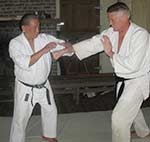 |
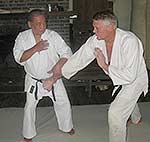 |
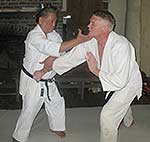 |
Roy Suenaka demonstrates a tuidi intercept and counter with Christopher Caile. In this photo Suenaka begins to parry Caile's right punch. |
Suenaka parries the punch downward and across his body, the attacker being pulled forward and off balance as Suenaka rotates to the outside. Suenaka keeps his right hand ready to counter. |
Roy Suenaka still controlling the right punch of Christopher Caile (having pulled it down and forward) rotates back (now square, but angled to the side) and executes a right open hand finger tip technique to Caile's throat. |
About The Interviewer:
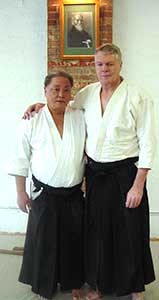 |
Roy Suenaka, founder of Wadokai Aikido, with Sensei Christopher Caile |
Christopher Caile is the founder and Editor of FightingArts.com. He is a senior member of Seido Karate based in New York City founded by Kaicho Tadashi Nakamura and a teacher level aikido practitioner under Roy Suenaka's Wadokai Aikido. |